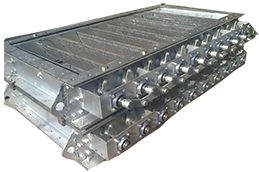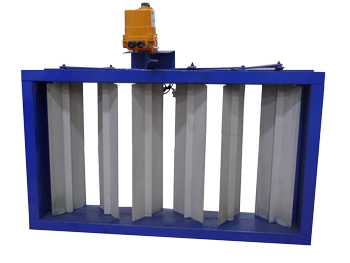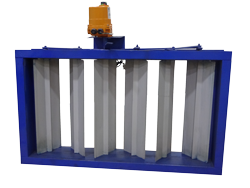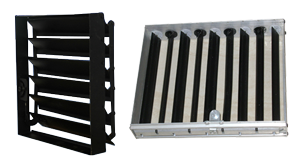Products


The louver type of damper consists of several blades mounted parallel across a duct, with centrally pivoted shafts extending out through a frame and driven by a linkage. Louver dampers are versatile, able in theory to handle any application in the power plant.
Some of their advantages:
Louver dampers have basic disadvantages, however. Here's a partial list:
The drive for a louver are simple, needing only 90° of motion. The torque requirement can vary widely over damper life, if corrosion and thermal effects are severe. Electric motors, air cylinders, and oil cylinders are able to actuate louver dampers with little difficulty.

Louver dampers are best applied to balance or control flow. The normal leak path of 0.7% of duct area produces a three to five percent leak rate in average applications.
As a general rule, a damper should be used in the middle third of the control range for best results. This gives equal percentage in either direction should the need arise.
A variety of options are available. Metallic spring seals, sealed (dust tight) blade ends, shear seals, and many materials are available.
Leakage performance of a louver depends on ratio of flowing to shutoff pressure, design temperature, number of blades, and blade edge treatment. Since the first two are system related, the last two are the usual areas of improvement. Reduction of number of blades reduces leak path to the limit that a single blade has only perimeter leakage.
are the most effective type of damper for controlling the flow of gases with the least disturbance to flow in ducts. Each pair of blades is carefully fitted to ensure precise operation in opposing directions, and thus creating highly controllable passages for the gas.
The frame is made from a formed or fabricated channel and is designed to withstand any system upset conditions. The blades are designed to adequately handle all loads, up to and including upset conditions with a maximum center span deflection determined by the engineering department so as to ensure smooth and trouble free operation. The drive shafts are supported in maintenance-free bearings. An adjustable floating packing gland seals the shaft passage through the damper frame. A special non-binding, fully adjustable external linkage is used to operate the damper. A wide variety of operators can be specified -electric, pneumatic, hydraulic or manual.
The Double Louver Damper is used to combine flow control with the capability of 100% isolation.
The damper is configured with two rows of blades in a common frame. 100% isolation is achieved by closing the blades and pressurizing the space between the two rows with clean air from ambient at a pressure greater than the upstream pressure in the duct. The clean air barrier prevents leakage of flue gas into the isolated area and also ventilates the downstream area with clean air.
Where a double louver damper forms a seal air barrier between seperate rows/banks of blades, a tandem damper has only on row of blades and the air chamber is formed between the upstream and downstream section of each blade.
The single set of shafts allows the number of blades to be minimized. Even wide blades can be contained within the minimum duct space required by a double louver.
In addition to eliminating the need for a second set of shafts, the wider blades allowed can reduce the number of blades in the damper. The smaller number of shafts substantially reduces the bearing and packing maintenance and operating torque.
This compact structure allows much more freedom of duct design than a conventional double louver.
We offer our clients with a wide gamut of qualitative Parallel Blade Dampers. These products are manufactured by making use of high-grade material, procured form the established vendors of the industry. Further, to cater to the diversified demands of the clients, we offer these dampers in different sizes and specifications.
Other information:
Our valued customers are presented with a qualitative Opposed Blade Dampers. These precisely designed opposed blade dampers allow unlimited airflow adjustment facility from any airflow panel. The offered products provide additional airflow than compared to other slide dampers. Moreover, we also provided these opposed blade dampers as per the clients requirements at a cost effective manner.
When To Use Opposed Blade Vs Parallel Blade:
Parallel Blade- Parallel blade dampers are usually selected for volume control from wide open to 75% of wide open. A relatively large control arm swing provides sensitive control through a relatively small change in air volume. Parallel blade dampers also offer the best first-cost selection for simple open-closed damper requirements.
Opposed Blade- Opposed blade dampers are selected for applications requiring volume control over a broad range, from wide open to 25% of wide open, as the control arm swing is more proportional to the damper effect.

These are Motorized Multi Louver Dampers with Direct Mounted Actuator which operate in unison to offer a smooth flow control of Blower Air. These are typically suitable for Industrial applications and mounted in ducts. These units are with a sturdy sheet metal construction suitable to handle large quantities of Air and are mounted at the Suction or delivery side of combustion air blowers. The operating actuators are directly coupled to the Damper shaft. This eliminates the linkage arrangement and thus the relatively tedious linkage settings. The end limits can be set by means of adjustable limit switches inside the actuator.
Features :
Specifications :

Installed behind grilles and diffusers, opposed blade volume control dampers help in adjusting air volumes to suit the requirements of the space as per the consultants design. The vertical louvers at 25 mm spacing facilitate even air distribution of the supply grille.
Features: